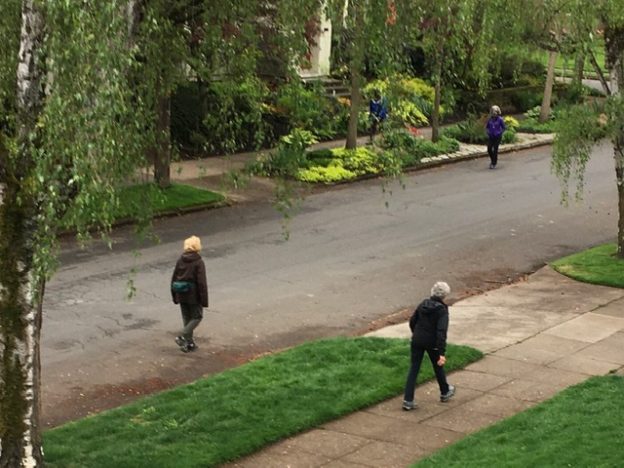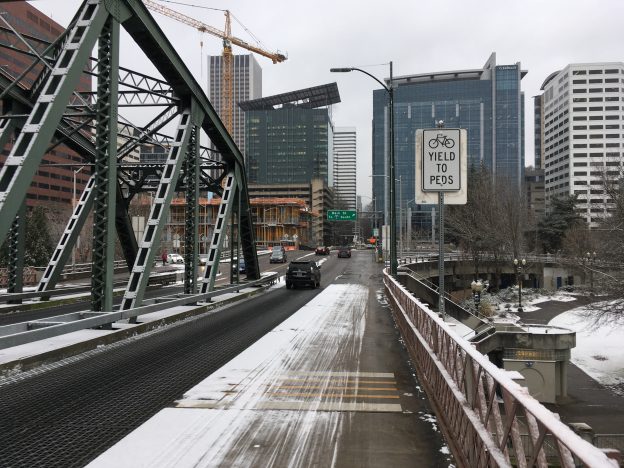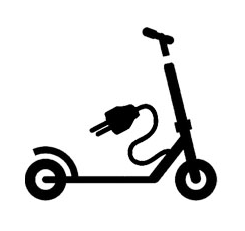Ray Thomas recently spoke on safety and legal issues often encountered by blind pedestrians in Oregon. See Ray’s blog post here: https://www.tcnf.legal/unique-safety-and-legal-issues-encountered-by-blind-pedestrians/

What are the legal rights and responsibilities of people walking and jogging in the roadway?
In our current time of widespread “shelter in place” orders, heading out for a neighborhood walk or jog is among the few available forms of exercise. With relatively high volumes of sidewalk traffic, and a desire to maintain appropriate social distances, many people find it necessary to divert from the sidewalk and walk or run, at least temporarily, in the roadway. People on foot have ample right of way protections on sidewalks and when using marked or unmarked crosswalks. However, when they veer into the roadway, their rights with respect to other modes diminish significantly.
ORS 814.070, entitled “Improper position upon or improperly proceeding along highway,” is a pedestrian-equivalent to Oregon’s “mandatory side path law” for bicyclists. Just as ORS 814.420 requires bicyclists to use a bicycle lane when one is available (subject to several important exceptions), ORS 814.070 prohibits people on foot from “tak[ing] a position upon or proceed[ing] along and upon the roadway where there is an adjacent usable sidewalk or shoulder.” Of course, in the age of mandatory 6 foot buffers between sidewalk users, a pedestrian using the roadway could argue that the sidewalk was not “usable” because it was occupied by another (potentially virus-carrying) person. However, even if that pedestrian is legally entitled to be in the roadway, ORS 814.040 requires, when outside of marked or unmarked crosswalks, that they “yield the right of way to all vehicles upon the roadway.” In other words, while pedestrians enjoy significant right of way protections on the sidewalk and in crosswalks, when otherwise travelling in the roadway they must yield to vehicles, including cars and bicycles.
Fortunately, in many parts of Portland, motor vehicle traffic is light, making compliance with Oregon law while in the roadway relatively straightforward. However, in the city’s denser areas, or on streets with high vehicle traffic volumes, pedestrians forced to use the roadway face additional risk of injury without legal recourse.
Oregon’s History with Idaho Stop, Including Recent Passage
Check out Ray Thomas’ recent article for the League of American Bicyclists on the history of Idaho Stop in Oregon, including, after many efforts, its recent passage.
See the blog post here.

E-scooters on Sidewalks and Bike Lanes, Oh My!
Gregg writes to ask what to do on his e-scooter when a bike lane goes onto the sidewalk, as it does on several Portland bridges. Of course scooters are required to use available bike lanes. ORS 814.514:
“[A] person commits the offense of failure of a motor assisted scooter operator to use a bicycle lane or bicycle path if the person operates a motor assisted scooter on any portion of a roadway that is not a bicycle lane or bicycle path when a bicycle lane or bicycle path is adjacent to or near the roadway [unless prohibited by local ordinance].”
But a scooter is not allowed on a sidewalk except to cross it to enter or leave adjacent property. ORS 814.524:
“A person commits the offense of unsafe operation of a motor assisted scooter on a sidewalk if the person operates a motor assisted scooter on a sidewalk, except to enter or leave adjacent property …”
So what to do when, as on the Broadway or Hawthorne bridges, the bike lane goes up onto what looks like a sidewalk? Or on Lovejoy eastbound west of NW 13th Avenue? Where the sidewalk IS the bike lane, how can you use the bike lane but stay off the sidewalk?
The technical answer on the bridges is that the concrete way that looks like a sidewalk doesn’t meet the definition of sidewalk because sidewalks are defined as being next to the “adjacent property line,” ORS 801.485, and what’s outside the railings on the bridges is a 40 foot drop to the river. That’s not “adjacent property,” and there’s no “line.”
On NW Lovejoy just west of NW 13th, where the bike lane is routed up onto the sidewalk behind the MAX shelter, take the bike lane, and tell the arresting officer you’re following the law that requires e-scooters to take the bike lane. (Besides, who wants to ride an e-scooter between the MAX tracks on Lovejoy?)

Introducing TCNF’s New Electric Scooter Legal Guide!
Thomas, Coon, Newton & Frost is pleased to announce our new electric scooter legal guide: Oregon E-Scooter Rights: A Legal Guide for Electric Scooter Riders. The guide was a team effort by TCNF personal injury attorneys Cynthia Newton, Ray Thomas, Jim Coon and Chris Thomas.
The guide covers several topics, including rules of the road, what to do if a crash occurs and insurance issues raised by e-scooters.
Here is a quick, ten point summary of e-scooter rules of the road, which are discussed in greater detail in our guide:
1) An e-scooter is a “vehicle” in the Oregon Vehicle Code and generally all traffic laws apply to it like other vehicles;
2) E-scooters may be operated like other vehicles, but not on sidewalks.
3) E-scooters may be ridden at speeds up to 15 mph on the public way.
4) E-scooters must use the bike lane if there is one and have the right of way just like a bicycle.
5) E-scooters may travel on any road with a speed limit of 25 mph or less.
6) E-scooters may take the lane unless it slows down other traffic and then like bicycles must travel as far to the right (or left on a one-way street) as “practicable”.
7) Any person 16 or older can ride an e-scooter on a public road.
8) E-scooter riders must wear a helmet, but lack of a helmet may not be used against the rider in an injury case in court if there is a crash.
9) E-scooter operators may not carry passengers.
10) E-scooters may not ride on City of Portland or State of Oregon park paths or trails.
Please feel free to contact us with any question on Oregon electric scooter law.
